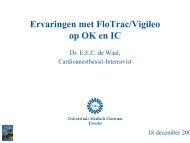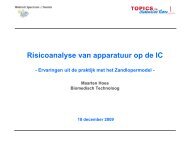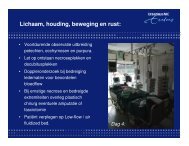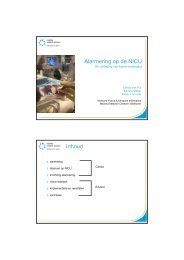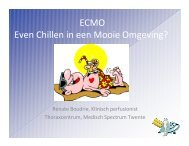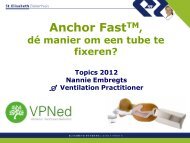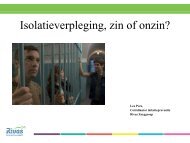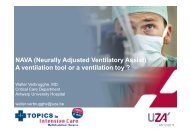Abstract 1 - Topics in Intensive Care
Abstract 1 - Topics in Intensive Care
Abstract 1 - Topics in Intensive Care
Create successful ePaper yourself
Turn your PDF publications into a flip-book with our unique Google optimized e-Paper software.
Title: The <strong>in</strong>troduction of Crew Resource Management <strong>in</strong> a large <strong>Intensive</strong> <strong>Care</strong> Unit<br />
Authors: Jeanette Vreman 1 , Monique Bonn 1 , Marck Haerkens 2 , Johannes van der Hoeven 1 and<br />
Joris Lemson 1<br />
1. Department of <strong>in</strong>tensive care medic<strong>in</strong>e, Radboud University Nijmegen, Medical Centre<br />
2. W<strong>in</strong>gs of <strong>Care</strong><br />
Introduction: Every year over 1500 patients die <strong>in</strong> Dutch hospitals due to medical errors while<br />
many more patients suffer from permanent or temporary physical damage. An important part of<br />
these errors are attributable to “Human Factors”. Ineffective communication and <strong>in</strong>correct<br />
preparation for <strong>in</strong>vasive procedures may expose patients to unnecessary risks. The <strong>in</strong>tensive<br />
care unit (ICU) environment is especially prone to these errors. S<strong>in</strong>ce three decades commercial<br />
and military aviation have adopted the Crew Resource Management (CRM) approach to mitigate<br />
the negative effects of unavoidable “Human Errors”. Recently the <strong>in</strong>tensive care department of<br />
the Radboud University Nijmegen Medical Centre has adopted the CRM pr<strong>in</strong>ciples. This abstract<br />
describes the implantation process.<br />
Method: S<strong>in</strong>ce 2010 more than 350 medical and nurs<strong>in</strong>g ICU staff members completed a twoday<br />
awareness course <strong>in</strong>to CRM pr<strong>in</strong>ciples and human factors. The course and additional<br />
coach<strong>in</strong>g were supported by a Dutch organization with professionals from civil and military<br />
aviation (W<strong>in</strong>gs of <strong>Care</strong>). Simultaneously, important local obstructions <strong>in</strong> patient care with regard<br />
to communication and patient safety were identified. The most important obstructions were<br />
addressed by assign<strong>in</strong>g specific safety tools, <strong>in</strong>tegrated <strong>in</strong> the CRM-environment. Furthermore a<br />
system was designed to assure cont<strong>in</strong>uous development and adherence to CRM rules.<br />
Results: The most important local obstructions <strong>in</strong> safety of patient care and the assigned<br />
counteract<strong>in</strong>g safety tools are depicted <strong>in</strong> table 1. Furthermore checklists for high-risk procedures<br />
were developed and brief<strong>in</strong>g and debrief<strong>in</strong>g procedures for these high-risk procedures were<br />
<strong>in</strong>troduced. F<strong>in</strong>ally, for team process surveillance, development of safety tools and for broad<br />
support we put together an ICU CRM core group. The effects of this “team climate <strong>in</strong>tervention”<br />
will be analyzed us<strong>in</strong>g a questionnaires (3 scales conta<strong>in</strong><strong>in</strong>g the Safety Attitude Questionnaire<br />
SAQ) and complication registration data. S<strong>in</strong>ce the <strong>in</strong>troduction, checklist procedures are felt to<br />
provide improved safety and support. At the same time professional communication between<br />
medical and nurs<strong>in</strong>g staff can still be improved. The CRM approach described represents a new<br />
culture that also requires a new professional behavior, the acceptance of which is not without<br />
challenges.<br />
Conclusion: Communication and collaboration between health care professionals can be<br />
improved <strong>in</strong> the ICU environment us<strong>in</strong>g CRM pr<strong>in</strong>ciples. Safety tools must be developed<br />
depend<strong>in</strong>g on the local circumstances. Acceptance of these tools and long-term adherence to the<br />
pr<strong>in</strong>ciples requires constant surveillance and feedback.<br />
local obstructions <strong>in</strong> patient care counteract<strong>in</strong>g safety tool<br />
Insufficient patient handover Structured handover form<br />
Insufficient communication between professionals Rules for professional communication<br />
Unstructured performance of high risk procedures<br />
Implementation of <strong>in</strong>tervention specific<br />
checklists <strong>in</strong>clud<strong>in</strong>g brief<strong>in</strong>g procedures<br />
Insufficient learn<strong>in</strong>g process from high risk procedures Implementation of a debrief<strong>in</strong>g procedure<br />
Table 1; Identified obstructions <strong>in</strong> patient care with counteract<strong>in</strong>g safety tools<br />
<strong>Abstract</strong> 6



